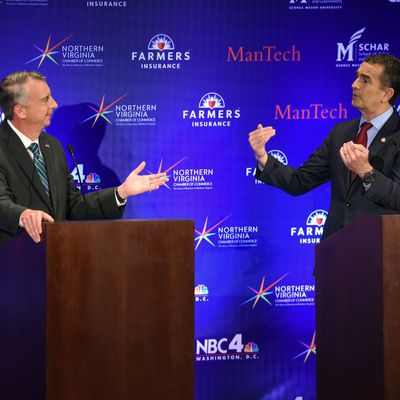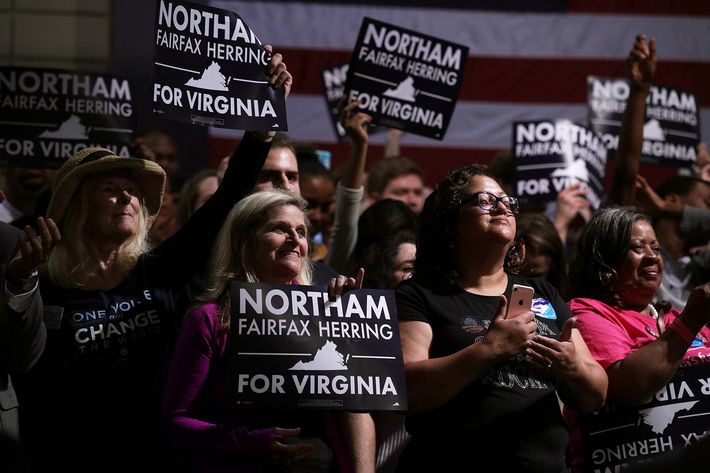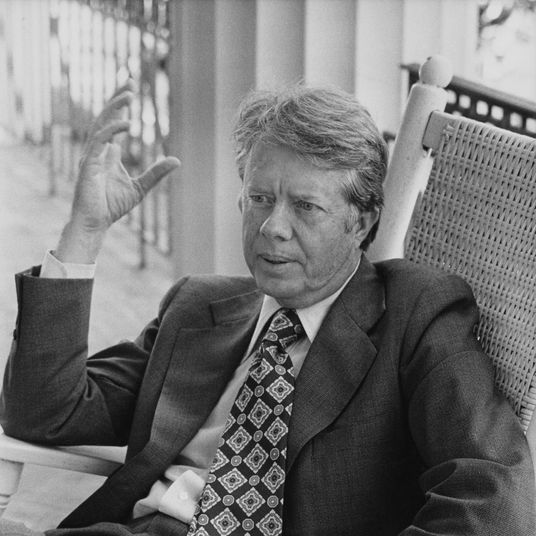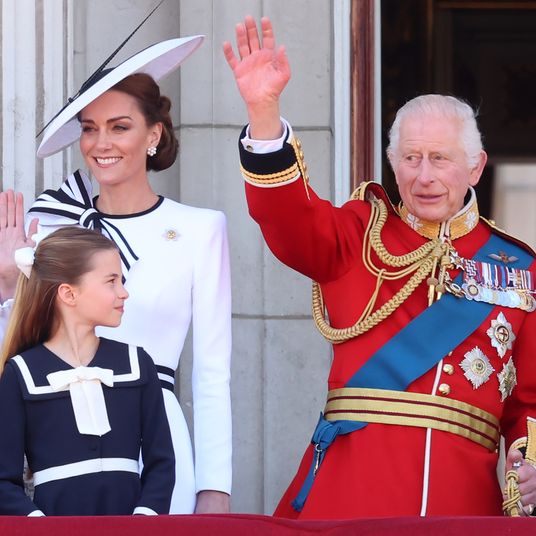
Off-year gubernatorial elections are endowed with prophetic national political significance. Those in Virginia are watched with particular interest, partly because of the state’s proximity to Washington, D.C., and partly because the Old Dominion has recently been a key battleground state in presidential elections.
This year’s gubernatorial race in Virginia is looking quite competitive in its final days, with Democratic lieutenant governor Ralph Northam’s once-robust lead over Republican Ed Gillespie down to 1.9 percent in the RealClearPolitics polling averages. Some polls actually have Gillespie in the lead, and an atmosphere of general uncertainty over the outcome has been promoted by an unusually broad variation in survey findings (in the last two weeks, one poll showed Northam up 17 points and another had Gillespie leading by eight).
The apparent tightening of the race has been accompanied by heavy and increasingly equal ad spending, which is breaking Virginia records. Northam maintained a big fundraising advantage for much of the general election, though Gillespie ran the first ads because he spent a lot less during his primary than did Northam. The possibility of a Gillespie upset seems to have opened some wallets; the Republican Governors Association gave his campaign nearly $5 million in October.
The campaign itself has shown Gillespie frequently on the offensive and Northam running what appeared to be a front-runner’s campaign focused on a few themes tailored to swing voters (particularly attacks on “Enron Ed” for his lobbying work on behalf of the failed oil giant back in the day). Gillespie, meanwhile, has chosen several harsh cultural themes for most of his messaging. At first, it was generally assumed he was simply trying to consolidate GOP support by appealing to supporters of his principal rival in the June primary, Cory Stewart. Stewart is a big-time Trump supporter and defender of Confederate monuments, and he finished a shockingly close second to Gillespie. But Gillespie has kept it up, with ads attacking Northam for voting against a bill to make nonexistent “sanctuary cities” illegal — which he linked to fears of the MS-13 criminal gang — and and other racially tinged ads attacking incumbent Gov. Terry McAuliffe’s restoration of felons’ rights. The Republican also appropriated Cory Stewart’s support for Confederate monuments.
Thus, the candidate who began the race as a reasonably moderate embodiment of Establishment Republicanism is closing with a notably Trumpite appeal, though he still doesn’t talk about the president (logically so, given Trump’s 42/53 approval ratio in the state). Earlier this week, the Washington Post suggested its polling showed Gillespie had “threaded the needle” by appealing to angry conservative voters in Trump Country without unduly alarming suburban swing voters.
The latter stages of the campaign have been accompanied by a lot of hand-wringing among Democrats, locally and nationally. While primary opponent Tom Perriello immediately endorsed Northam after the latter’s surprisingly easy nomination victory, some backers of the former congressman have complained that Northam is running an unimaginative and uninspiring campaign much like Hillary Clinton’s last year. A fresh sign of disunity (though perhaps more nationally than locally) burst out Friday when the progressive Democrats for America organization, which supported Perriello in the primary, suspended any cooperation with the Northam campaign to protest the candidate’s “clarification” yesterday that he would sign a bill banning sanctuary cities in Virginia if any were actually created — a statement DFA called “gutless, politically senseless, and morally debased.” To cheers from some Democrats and jeers from others, a Latino group launched a late ad with images (nearly as lurid as those in Gillespie’s ads) of redneck Gillespie supporters trying to run over minority children with their pickup trucks. While the Northam campaign did not authorize the ad, it did dramatize Democratic fears that minority turnout will be lower even as white working-class voters throng to the polls.
There’s no question that Virginia Democrats are spooked about this election in part because their last two non-presidential statewide candidates, Terry McAuliffe in 2013 and Sen. Mark Warner in 2014, significantly undershot their poll numbers, though they did both narrowly win. McAuliffe won by 2.5 percent while leading by 6.7 percent in the RealClearPolitics polling average. And Warner won by an eyelash despite being ahead nearly ten points in the polling average. His opponent, as it happens, was Ed Gillespie.

Geographically, Virginia has major political as well as cultural and economic divisions. Booming Northern Virginia, centered in the Washington, D.C., suburbs, has been trending Democratic in recent years. It’s the least “southern” of the regions culturally; it has a lot of immigrants, college graduates, and federal employees. In 2016 (according to exit polls), the D.C. suburbs represented 19 percent of the statewide vote, and the NoVa exurbs (much more competitive politically) represented 17 percent. Clinton won the former 68/27 and the latter 48/46. Other pro-Democratic areas rely on a large African-American vote, notably the City of Richmond and the Hampton Roads region around Norfolk. The suburbs around both cities lean Republican but can occasionally “swing.” Together, greater Richmond and the Tidewater and nearby counties represented 43 percent of the vote in 2016. The heart of the Republican vote is in central and western Virginia (the latter running from the Shenandoah Valley down to the former coal-mining region of Southwest Virginia). Representing 21 percent of the statewide vote in 2016, this region went heavily (64/31) for Trump. Particularly in the old coal- and tobacco-producing areas, this part of the state is not doing well at all economically.
While Gillespie is from northern Virginia and Northam is from Norfolk, their patterns of support may not differ much from that exhibited by Clinton and Trump in 2016. A fairly typical late poll (from Suffolk) showing Northam with an overall four-point lead had him up 59/41 in the north of the state and doing nearly as well in Tidewater, but down 26/74 in Western Virginia and trailing slightly in greater Richmond.
Turnout could well be the deciding factor. While turnout among African-American voters in Virginia does not fall off as much in non-presidential races as it has done in many other states, the white percentage of the smaller off-year electorate is typically higher: 72 percent in 2013, and 78 percent in 2009, as opposed to 67 percent in 2016.
If there is any intangible factor in this election, it could be history: In nine out of the last ten Virginia gubernatorial elections, the party controlling the White House lost. The one exception was the most recent election, when Democrat McAuliffe broke the streak. McAuliffe’s win was interpreted by many observers at the time as indicating that Virginia had become a blue state rather than a hypercompetitive purple state.
Should Northam win by a decent margin, the national implications of this election could be limited: The favored candidate from the favored party with good positioning and plenty of money would have prevailed, albeit not by the landslide that might have clearly indicated an impending Democratic “wave” in 2018. Even in that scenario, the composition of Northam’s vote, and the turnout patterns, might be instructive: Did, for example, Gillespie’s nasty ads turn off college-educated white voters or stimulate turnout by minority voters?
If, on the other hand, Gillespie wins, or perhaps even if he loses in a late-night squeaker, the 2018 implications could be ominous for Democrats. In Virginia itself, given the GOP’s huge margin of control in the state House of Delegates (all 100 seats are up this year), a Gillespie win would give Republicans “trifecta” control of yet another state government, and one where redistricting can affect both congressional and legislative maps significantly. Beyond Virginia, it would have three serious implications.
First, it would show that even a career denizen of the Swamp like Gillespie can appropriate Trumpian cultural themes and attract Trumpian voters without losing the Republican and swing voters who aren’t especially agitated about immigration or crime or fearful of minorities. That could very easily become a template for GOP candidates in 2018, particularly in places with more non-college-educated white voters than Virginia has.
Second, depending on turnout patterns, a Gillespie win might indicate that one of the assumptions underlying predictions of a Democratic wave in 2018 is wrong: the belief that anti-Trump enthusiasm will more than offset midterm falloff among the young and minority voters most likely to vote Democratic.
And third, a Northam loss would intensify and extend Democratic infighting nationally. You could count on a cascade of “struggle for the soul of the Democratic Party” articles, accompanied by left-and-center-left recriminations and finger-pointing. Just weeks after the punditocracy viewed the GOP as being torn asunder by its strange and divisive leader, Republicans would look like the party that is pulling in the same (if sinister) direction.
Yes, it is an off-year election with big-time consequences unless Ralph Northam pulls off the kind of boring, predictable win so many expected earlier this year.






























